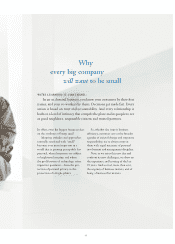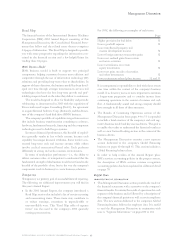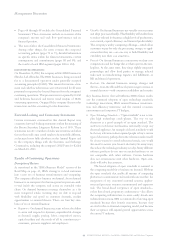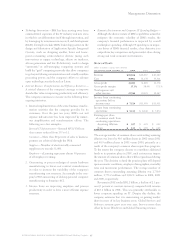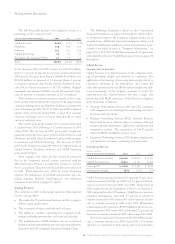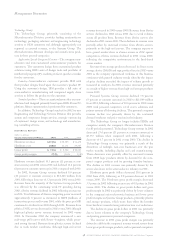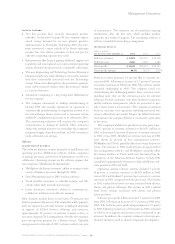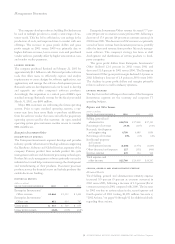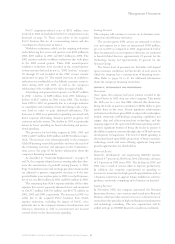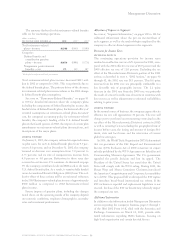IBM 2002 Annual Report Download - page 47
Download and view the complete annual report
Please find page 47 of the 2002 IBM annual report below. You can navigate through the pages in the report by either clicking on the pages listed below, or by using the keyword search tool below to find specific information within the annual report.
Management Discussion
45international business machines corporation and Subsidiary Companies
■
Technology Innovations
—
IBM has been moving away from
commoditized segments of the IT industry and into areas
in which it can differentiate itself through innovation, and
by leveraging its investments in research and development
(R&D). Examples include IBM’s leadership position in the
design and fabrication of Application Specific Integrated
Circuits; work on designing smaller, faster and lower-
power-consuming semiconductor devices (using such
innovations as copper technology, silicon on insulator,
silicon germanium and low-K dielectric); work to design
“autonomic” or self-managing computing systems and
build the “grid” computing networks that allow computers
to go beyond sharing communications and actually combine
processing power; and the company’s efforts to advance
open technology standards such as Linux.
■
Internal Business Transformation and Efficiency Initiatives
—
A critical element of the company’s strategy to improve
shareholder value is improving productivity and efficiency.
The company continues to execute on the following three
ongoing initiatives.
1. Internal implementation of the same business transfor-
mation activities that the company provides for its
customers. Over the past ten years, IBM’s cost and
expense infrastructure has been improved by numer-
ous simplification and transformation efforts. The
following are a few examples:
Internal IT Infrastructure
—
Internal MVS/VM host
data centers reduced from 155 to 11.
Customers
—
More than 80 percent of sales to business
partners are achieved through the Web.
Suppliers
—
Number of electronically connected
suppliers now exceeds 31,000.
Employees
—
eLearning represents almost 50 percent
of all employee training.
2. Outsourcing or process redesign of certain hardware
manufacturing to lower-cost contract manufacturers
in order to increase the variability of the company’s
manufacturing cost structure. An example is the com-
pany’s 2002 outsourcing of desktop personal computer
manufacturing to Sanmina
–
SCI.
3. Intense focus on improving employee and process
productivity in order to drive a more efficient expense
structure.
■
Economic Environment and Corporate IT Spending Budgets
—
Although the diverse nature of IBM’s capabilities somewhat
mitigates the economic volatility of IBM’s results, the
company’s financial performance is impacted by overall
marketplace spending. Although IT spending is an impor-
tant driver of IBM’s financial results, a key objective is to
outperform key competitors and gain market share during
strong and weak economic environments.
Historical Results
(dollars in millions except per share amounts)
for the year ended december 31: 2002 2001 2000
Revenue $«81,186 $«83,067 $«85,089
Cost 50,902 51,178 53,511
Gross profit «30,284 «31,889 «31,578
Gross profit margin 37.3% 38.4% 37.1%
Total expense and
other income 22,760 20,439 20,167
Income from continuing
operations before
income taxes $«««7,524 $«11,450 $«11,411
Income from continuing
operations $«««5,334 $«÷8,146 $«««7,874
Earnings per share
of common stock from
continuing operations:
Assuming dilution $«««««3.07 $÷÷«4.59 $«««««4.32
Basic $«««««3.13 $÷÷«4.69 $÷÷«4.45
The average number of common shares outstanding assuming
dilution was lower by 40.3 million shares in 2002 versus 2001
and 40.9 million shares in 2001 versus 2000, primarily as a
result of the company’s common share repurchase program.
To the extent the company chooses to contribute additional
funds to its pension plans in 2003, such actions may impact
the amount of common shares that will be repurchased during
the year. The decision to fund the pension plans will depend
upon economic conditions, employee demographics, mortality
rates and investment performance. The average number of
common shares outstanding assuming dilution was 1,730.9
million, 1,771.2 million and 1,812.1 million in 2002, 2001
and 2000, respectively.
Revenue in 2002 totaled $81.2 billion, a decline of 2.3 per-
cent (3 percent at constant currency) compared with revenue
of $83.1 billion in 2001. This was primarily attributable to
lower corporate spending on IT. Despite this decline, the
company estimates that it is maintaining or gaining market
share in most of its key business areas. Global Services and
Software revenue grew year over year, but was more than
offset by lower Hardware and Global Financing revenue.


